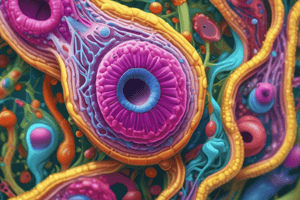Podcast
Questions and Answers
What did Thomas Hunt Morgan use for his genetic research?
What did Thomas Hunt Morgan use for his genetic research?
- Rabbits
- Mice
- Pea plants
- Fruit flies (correct)
Thomas Hunt Morgan won a Nobel Prize for his work on plant genetics.
Thomas Hunt Morgan won a Nobel Prize for his work on plant genetics.
False (B)
In which year did Thomas Hunt Morgan earn his PhD?
In which year did Thomas Hunt Morgan earn his PhD?
1890
Thomas Hunt Morgan was born in __________.
Thomas Hunt Morgan was born in __________.
Match the following events with their corresponding years:
Match the following events with their corresponding years:
Where did Thomas Hunt Morgan conduct his 'Fly Room' experiments?
Where did Thomas Hunt Morgan conduct his 'Fly Room' experiments?
Morgan's early work was discontinuous with Mendel's theories.
Morgan's early work was discontinuous with Mendel's theories.
What was one of the main focuses of Morgan's research at Bryn Mawr College?
What was one of the main focuses of Morgan's research at Bryn Mawr College?
Flashcards are hidden until you start studying
Study Notes
Early Life and Education
- Thomas Hunt Morgan was born in 1866 in Kentucky to a wealthy family.
- His early interest in nature led him to study science at the University of Kentucky.
- He obtained his PhD in zoology from Johns Hopkins University in 1890.
- Started teaching and researching embryology at Bryn Mawr College in 1891.
Research and Contributions
- Morgan's work at Columbia University in 1904 significantly advanced genetics research.
- He built upon Gregor Mendel's theories about inheritance using fruit flies in his "Fly Room" lab.
- Morgan's experiments with fruit flies helped confirm and expand Mendel's laws of heredity.
- Fruit flies were ideal due to their short generation time (around 10 days).
Milestones
- Started research on experimental embryology and differentiation at Bryn Mawr in 1891.
- Established his "Fly Room" and began fruit fly breeding experiments in 1908 at Columbia.
- Published a landmark text on heredity in 1915, solidifying his role in establishing modern genetics.
- Moved to Caltech in 1928, becoming head of biology, and helped establish a marine biology research unit.
- Awarded the Nobel Prize in Physiology or Medicine in 1933 for his work on inheritance patterns.
Studying That Suits You
Use AI to generate personalized quizzes and flashcards to suit your learning preferences.




